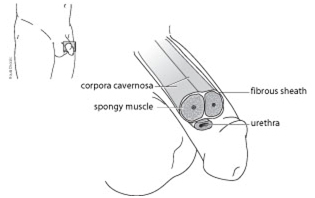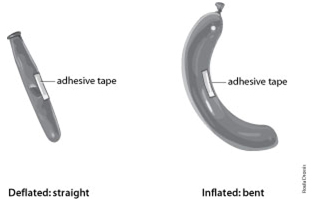
Named after the French surgeon who described it in 1743, Peyronie’s (pronounced pay-ro-knees) Disease is an inflammatory condition of the penis resulting in scar formation and curvature of erections. It affects at least 1% of all men.
The penis is made up of three cylinders wrapped in a skin tube. On its undersurface is the urethra, through which urine flows during voiding. Above the urethra are two elastic, fibrous cylinders (the corpora cavernosa) fused in the midline and anchored on the pelvis. These structures contain blood vessels and spongy muscle which relax with sexual stimulation to allow engorgement with blood producing an erection.
Peyronie’s Disease is due to the formation of dense scar tissue in the fibrous sheath of the corpora cavernosa. In its early stages, the area of scarring may be tender and painful. A discrete lump, or plaque, can sometimes be felt on the penile shaft. This inelastic scar tissue prevents stretching of the fibrous sheath with erection resulting in curvature. Picture the penis as a long narrow balloon with a piece of adhesive tape on one side. The deflated balloon is straight, but with inflation it will bend to the side of the adhesive tape.

The precise cause of Peyronie’s Disease is not clear. Many believe that injury to the erect penis, such as buckling of the shaft during intercourse, may result in shearing between the layers of the fibrous sheath and bleeding. In most men, this injury would heal without residual effect. Others, however, have an abnormal inflammatory response resulting in unusual scarring. Some men appear to be genetically predisposed to this abnormal scar formation, having similar tender and restrictive scars in the palms (Dupuytren’s contracture).
Typically, Peyronie’s Disease affects middle-aged men (age 45 – 60), although it has been reported in younger and older men. It is more common in those with erectile dysfunction, diabetes or high blood pressure. Erections may be painful and sexual intercourse may be awkward or uncomfortable for the man and/or his partner. The degree of curvature is variable while its direction is constant: up, down or to one side. Scarring may cause indentation or shortening of the erect penis. In some cases, the penis beyond the scarring may not become firm with erections.

The course of Peyronie’s Disease is usually one of slow evolution of the penile scar. Pain or tenderness in the area of scarring will often disappear after the first year or two. Maturation of the scar may result in shrinkage of the penile lump and improvement of the degree of curvature.
Some men with Peyronie’s Disease have difficulty achieving or maintaining full erections, not necessarily caused by the condition. Many couples are able to continue to have satisfactory sexual intercourse despite the penile curvature. In some cases, however, the degree of curvature and its persistence will require surgical correction.
An examination of the penis will detect a lump or tenderness in the area of curvature. A photograph of the erect penis may be useful to record the degree and direction of curvature. Other investigations are rarely necessary unless surgical repair is being considered.
The goal of treatment is to reduce pain and optimize sexual function. Further injury may be prevented by avoiding vigorous sexual activity when an erection is not entirely firm. Various treatments have been proposed to correct Peyronie’s Disease, but none have proven entirely effective or reliable. In many cases the penile curvature will improve or resolve even without treatment.
Antioxidants, such as vitamin E, taken for at least three months may accelerate scar maturation and healing. Potassium aminobenzoate (Potaba™), taken for six to 12 months, is thought to prevent new scarring. Other oral medications have been used with variable success.
Injection of drugs into the plaque (often every week for up to 12 weeks) has been proposed to reduce inflammation and accelerate healing of the scar. The long term results of this treatment are unknown.
Surgical treatment of Peyronie’s Disease usually is delayed for at least one year after the onset of the problem to allow maturation of the scar and the possibility of spontaneous improvement. Surgery may be necessary to improve the appearance of the penis or to correct a curvature that is interfering with satisfactory sexual intercourse.
There are different surgical approaches used for the correction of the penile curvature resulting from Peyronie’s Disease. The most common is the Nesbit procedure in which sutures are placed in the fibrous sheath on the side opposite to the area of scarring to counteract the inelastic segment and straighten the penis, albeit with some loss of length.
In some, the plaque can be removed and replaced with a graft of synthetic or natural material. Occasionally, and particularly when a man has difficulty achieving and/or maintaining his erection, the problem is best treated by placing a penile implant orprosthesis, a pair of mechanical or hydraulic rods inserted into the corpora cavernosa to produce penile rigidity.